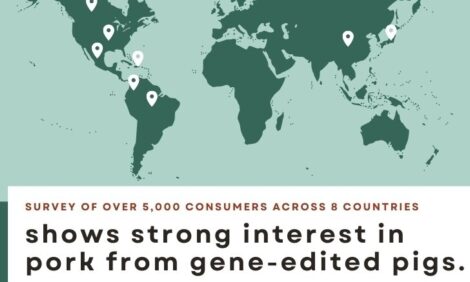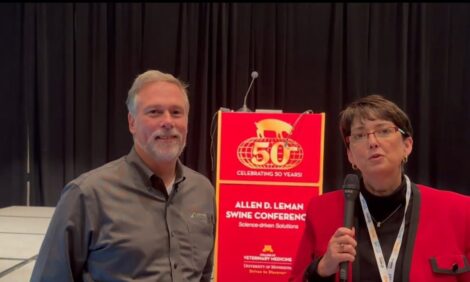



Aerosol transmission of porcine reproductive and respiratory syndrome virus (PRRSv).
By Dr. Morgan Morrow, NCSU Swine Extension - Dr. Robert Desrosiers of St. Hyacinthe, Quebec, delivered the prestigious Howard Dunne Memorial Lecture at the annual meeting of the American Association of Swine Veterinarians in Des Moines, Iowa, in March. His full lecture on "Epidemiology, Diagnosis, and Control of Swine Diseases" is available in the proceedings. Below are his comments on the aerosol transmission of porcine reproductive and respiratory syndrome virus (PRRSv).
 Dr Morgan Morrow Swine Veterinary Specialist |
In 1991, a meeting on PRRS was organized in Brussels, Belgium, which drew scientists and researchers from around the world. One of the conclusions of this meeting was the following: "The main means of spread of PRRS are the farm-to-farm movement of pigs and airborne dispersion. The first outbreaks in a population frequently have been due to the movement of infected pigs, but airborne transmission appears to be responsible for much of the subsequent neighborhood spread."1
Robertson2 reported the means by which the virus was thought to have spread in the first 100 reported cases in Great Britain. Aerosol was the most important with 63 percent of the cases. He also reported the same tentative conclusions for 81 cases that occurred in Belgium in 1991 and for which airborne spread was considered to have been involved in 69 percent of the cases (Belgians talk more about "neighborhood infection" than "airborne spread").
Vannier3 described the progression of the virus in the French Cotes d'Armors from October 1991 to May 1992. He concluded that only aerosol transmission over a short distance could explain the diffusion observed, which occurred during the cold season. In The Netherlands, Komijn et al.4 stated that one of the reasons why the disease initially spread so fast in that country was that the direction of the wind and the weather conditions during the winter months favored the spread of airborne virus. The number of outbreaks thought to have been caused by PRRS went from 10 between December 17, 1990, and January 13, 1991, to 1,019 between January 14 and March 10, 1991. The presence of the virus in Denmark was identified for the first time in March 1992 and was suspected of having been introduced from Germany via the airborne route.5
An epidemiological study was conducted in Denmark in 1996-97.6 Seventy-three case herds and 146 control herds were included. One of the conclusions was that biosecurity measures did not prevent infection of the herds, and the authors suggested that the virus spread from neighboring herds by aerosol. They used a formula to quantify the risk of neighborhood exposure. In their model, a herd located 300 meters from an infected farm was 45 times more likely to become infected than a same-size farm that had no contaminated neighbor within 3 kilometers (km).
In another epidemiological study conducted in Denmark, this time for the period 1994-98, a total of 344 genetic herds were evaluated.7 The average annual incidence of infection was found to be about 8 percent. The analysis indicated that the risk of infection increased with the pig density of PRRS-positive neighbors, but decreased with distance from them. The authors concluded that there was a predominant feature of locally spread PRRS virus in Danish pig herds, probably mainly via airborne transmission.
In North America, six different studies or field investigations reported transmission of the virus by the so-called "area spread."8-13 In each of these studies, sequencing of strains suggested that what appeared to be the same strains were found, within a relatively short period of time, in neighboring farms without a simple explanation as to how they were introduced onto these farms. In five of six studies, the authors referred to the possibility of aerosol involvement in the area spread, but it is understood that there were other possible transmission means, such as insects.8,9-13 It should be noted, however, that in the epidemiological study conducted in Quebec by Larochelle et al.,12 about 75 percent of the total PRRS strains identified (226) were from cases submitted in autumn and winter, and particularly from November through April, a time of the year during which, in most of the cases, insect involvement was unlikely. The same is true for two of the field investigations referred to above, where cases of area spread occurred in the cold season.11,13 In one of these, six Quebec farms developed PRRS within a month, in November-December. 13 All were relatively close—from 100 meters to about 2 km from each other. Three were independent producers, and three were owned by the same company. Four of the farms used negative replacement animals, as well as semen from a PRRS-negative boar stud. Strains from these four farms were sequenced, and all were found to be 99.5 percent homologous or more, using ORF 5.
This is not to say that aerosol transmission is the only possible cause of area spread of this virus. In another one of these field investigations, 12 backyard pigs were thought to be responsible for the contamination of a negative sow herd located half a mile away.14,15 One would think that even though it has been shown that as few as 20 virions are enough to infect a pig by intranasal inoculation, 12 pigs might not generate an aerosol capable of infecting other pigs at such a distance. Without disregarding aerosol in that particular case, which occurred during the summer, transmission by other means—insects, for example—should remain on the list of possibilities. It should be mentioned as well that if only 12 pigs located half a mile away were really responsible for this indirect transmission, might not trucks or vans containing hundreds of pigs that could be viremic and shedding virus also constitute sources of contamination?
Going back to aerosol per se, PRRS virus is probably the organism over which the aerosol debate has been the hottest. There seems to be ample field evidence suggesting the possibility that PRRS virus can be transmitted by aerosol. The doubt has come mainly from the fact that reproducing aerosol transmission of this pathogen over short distances has been, at least in some of the experiments, either difficult or impossible to demonstrate. These experiments were largely described at this and other meetings in the past, so I will not go over them. In Denmark, though, Kristensen et al.14 were able to readily infect negative pigs when 70, 10, or even as low as 1 percent of the air getting into their closed unit came from another unit, distanced by one meter, containing infected pigs. Finally, a recent study by Dee15 looked at the possibility for the virus to be isolated in the air of a tube at different distances from its production point. Conducted during the winter, the study showed that the virus could be isolated at all distances tested, including the longest one, 150 meters, and one of two pigs exposed to infected aerosol over this longest distance became infected.
References
1. Anonymous. Porcine reproductive and respiratory syndrome (PRRS). Proc Seminar on Porc Reprod and Resp Syndr. Brussels, Belgium. 1991:Conclusions, 2.
2. Robertson IB. Porcine reproductive and respiratory syndrome (blue-eared pig disease): Some aspects of its epidemiology. Proc Soc Vet Epi Prev Med. Edinburgh, Scotland. 1992:24-37.
3. Vannier P. Concepts generaux sur la transmission des maladies infectieuses entre les elevages porcins et la persistance des agents infectieux au sein des elevages. Proc Jour Recher Porc France. 1993:321-328.
4. Komijn RE, van der Sande WJH, van Klink EGM. Report on the epidemiology of PRRS in The Netherlands. Proc Seminar on Porc Reprod and Resp Syndr. Brussels, Belgium. 1991:8-12.
5. Mortensen S, Madsen K. The occurrence of PRRS in Denmark. AASP newsletter. 1992:4:48.
6. Mortensen S, Stryhn H, Sogaard R, Boklund A, Stark KDC, Christensen J, Willeberg P. Risk factors for infection of sow herds with porcine reproductive and respiratory syndrome (PRRS) virus. Prev Vet Med. 2002:53:83-101.
7. Zhuang Q, Barfod K, Wachmann H, Mortensen S, Willeberg P. Serological surveillance for PRRS in Danish genetic pig herds and risk factors for PRRS infection. Proc IPVS. Ames, Iowa. 2002:2:231.
8. Lager KM, Mengeling WL, Wesley RD. Evidence for local spread of porcine reproductive and respiratory syndrome virus. J Swine Health Prod. 2002:10:167-170.
9. Mohr MF, Rossow KD. Upper porcine reproductive and respiratory syndrome (PRRSv) sequences identified in four Minnesota swine herds. Proc AAVLD. 2002:42.
10. Daniels, CS. Area spread of PRRS virus from a small population of backyard pigs. Proc AASV Pre-Conference Seminar on: Preventing and Controlling PRRSV: Mission Impossible? Orlando, Florida. 2003:29-33.
11. Torrison J, Rossow K, Olson S. Molecular evidence of area spread of PRRS virus among neighboring swine farms. Proc Int Symp Swine Dis Erad. St. Paul, Minnesota. 2001:89-91.
12. Larochelle R, D'Allaire S, Magar R. Molecular epidemiology of porcine reproductive and respiratory syndrome virus (PRRSv) in Quebec. Virus Res. 2003:96:3-14.
13. Desrosiers R. Aerosol spread of the PRRS virus: Why it is too early to say no. Int Pigletter. 2002:22:21-23.
14. Kristensen CS, Botner A, Angen O, Sorensen V, Jorsal SE, Takai H, Barfod K, Nielsen JP. Airborne transmission of A. pleuropneumoniae and PRRS virus between units. Proc IPVS. Ames, Iowa. 2002:1:272.
15. Dee, S. The "Alaskan pipeline": A new model for evaluating aerosol transmission of swine pathogens. Int Pigletter. 2003:23:15-18.
Adapted by Morgan Morrow, from Robert Desrosiers, DVM, Dipl ABVP, Howard Dunne Memorial Lecture, as presented at the American Association of Swine Veterinarians Annual Meeting, March 6-9, 2004, Des Moines, Iowa.
To read the full newsletter, please click here
Source: North Carolina State University Swine Extension - June 2004







